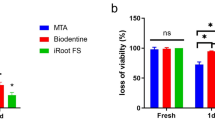Abstract
Marked bactericidal activity of the electrolyzed acid water (EAW) and its less undesirable effects on biological tissues and the environment has been successfully utilized in dental practice. A review of literature reveals that not many studies have been performed to determine the disinfection effect of EAW on heat cured acrylic denture bases. The objective of the study is to determine the efficacy of EAW in disinfecting heat cured acrylic resin specimens as compared to the efficacy of disinfecting the specimens using 2% glutaraldehyde. Heat cured acrylic resin plates were immersed in Bacteria suspensions of Staphylococcus aureus and later disinfected using EAW which was produced using a custom made electrolyzing apparatus and 2% glutaraldehyde for different time intervals. The numbers of surviving bacteria were counted. As the control, the bacteria attached on the specimens were counted with out any disinfection treatment. The results obtained were statistically analyzed using ANOVA and post-hoc test. The disinfection potential of 2% glutaraldehyde was better than EAW when the specimens were disinfected for 1 and 3 min. Where as when the disinfection time was increased to 5 min there was no difference between EAW and 2% glutaraldehyde. However considering that the disinfecting time can be easily extended to 5 min, EAW can be effectively used for disinfecting the acrylic denture.









Similar content being viewed by others
References
Powell GL, Runnells RD, Saxon BA, Whisenant BK (1990) The presence and identification of organisms to dental laboratories. J Prosthet Dent 64:235
ADA Council on Scientific Affairs and ADA Council on Dental Practice (1996) Infection control recommendations for the dental office and dental laboratory. J Am Dent Assoc 127:672–680
Ananthanarayan Paniker CKJ (2000) Text book of microbiology, 6th edn. Orient Longman Publishers, Hyderabad, pp 178–186
Rudd RW, Senia ES, McCleskey FK, Adams ED (1984) Sterilization of complete dentures with sodium hypochlorite. J Prosthet Dent 51(3):318–321
Chau VB, Saunders TR, Pimster M, Elfring DR (1995) In depth disinfection of acrylic resins. J Prosthet Dent 74:309–313
Shen C, Javid NS, Colazzi FA (1989) The effect of glutaraldehyde disinfectants or denture base resins. J Prosthet Dent 61(5):583–589
Bell JA, Brockmann SL, Fel P, Sackuvich DA (1989) The effectiveness of two disinfectants on denture base acrylic resin with an organic load. J Prosthet Dent 61(5):580–583
Brace ML, Plummer KD (1993) Practical denture disinfection. J Prosthet Dent 70:538–540
UnLu A, Altay OT, Sahmali S (1996) The role of denture cleansers on the whitening of acrylic resins. Int J Prosthodont 9:266–270
Ma T, Johnson GH, Gordon GE (1997) Effects of chemical disinfectants on the surface characteristics and color of denture resins. J Prosthet Dent 77(2):197–204
Mc Name SJ, Von Gonten AS, woalsey GD (1991) Effects of laboratory disinfecting agents on color stability of denture acrylic resins. J Prosthet Dent 66:132–136
Nikawa H, Iwanaga H, Hamada T, yuhta S (1994) Effects of denture cleansers on direct soft denture lining materials. J Prosthet Dent 72:657–662
Ichihara T, Fujii G, Eda T, Sasaki M, Veda Y (2004) The efficacy function water (electrolyzed strong acid solution) on open heart surgery; post operative mediastinitis due to methicillin-resistant Staphylococcus aureus. Kyobu Geka 57(12):110–112
Machado AP, Fischman O, Geocze S (2005) Microbiological evaluation of gastroscope decontamination by electrolyzed acid water. Arq Gastroenterol 45(1):60–62
Lee JH, Rhee PL, Kim JH, Kim JJ, Paik SW, Rhee JC, Song JH, Yeom JS, Lee NY (2004) Efficacy of electrolyzed acid water in reprocessing patient-used flexible upper endoscopes: comparison with 2% alkaline glutaraldehyde. J Gastroenterol Hepatol 19(8):897–903
Yahagi N, Kono M, Kitahara M, Ohmura A, Sumita O, Hashimoto T, Hori K, Nig-Juan C, Woodson P, Kubota S, Murakami A, Takamoto S (2000) Effect of electrolyzed water on wound healing. Artif Organs 24(12):984–987
Morita C, Sano K, Morimatsu S, Kiura H, Goto T, Kohno T, Hong WU, Miyoshi H, Iwasawa A, Nakamura Y, Tagawa M, Yokosuka O, Saisho H, Maeda T, Katsuoka Y (2000) Disinfection potential of electrolyzed solutions containing sodium chloride at low concentrations. J Viral Methods 85(1–2):163–174
Fabrizio KA, Sharma RR, Demirci A, Cutter CN (2002) Comparison of electrolyzed oxidizing water with various antimicrobial interventions to reduce salmonella species on poultry. Poult Sci 81(10):1598–1605
Sharma RR, Demrici A (2003) Treatment of Escherichia coli (0157:H7) inoculated alfalfa seeds and sprouts with electrolyzed oxidizing water. Int J Food Microbial 86(3):231–237
Kim C, Hong YC, Brackett RE (2000) Roles of oxidation–reduction potential in electrolyzed oxidizing and chemically modified water for inactivation of food-related pathogens. J Food Prot 63(1):19–24
Horiba N, Hiratsuka K, Onoe T, Yoshida T, Suzuki K, Matsvmoto T, Nakamura H (1999) Bacterial effect of electrolyzed neutral water on bacteria isolated from infected root canals. Oral Surg Oral Med Oral Pathol Oral Radiol Endod 87(1):83–87
Ito K, Nishida T, Marai S (1996) Inhibitory effects of acid water prepared by an electrolysis apparatus on early formation on specimens of dentine. J Clin Periodontol 23:471–476
Kohono S, Kawata T, Kku M, Fujita T, Tsutsui K, Ohtani J, Tenjo K, Motokawa M, Tohma Y, Shigekawa M, Kamata H, Tanne K (2004) Bactericidal effects of acidic electrolyzed water on the dental unit waterline. Jpn J Infect Dis 57:52–54
Nagamastu Y, Tajima K, Kakigawa H, Kozono Y (2001) Application of electrolyzed acid water on the denture base. Part 1. Examination of sterilization of effects on resin plate. Dent Mater J 20(2):148–155
Author information
Authors and Affiliations
Corresponding author
Additional information
This article presented at the 36th IPS conference, Bangalore.
Rights and permissions
About this article
Cite this article
Jnanadev, K.R., Satish Babu, C.L., Shilpa Shetty, S. et al. Disinfecting the acrylic resin plate using electrolyzed acid water and 2% glutaraldehyde: a comparative microbiological study. J Indian Prosthodont Soc 11, 36–44 (2011). https://doi.org/10.1007/s13191-011-0057-x
Received:
Accepted:
Published:
Issue Date:
DOI: https://doi.org/10.1007/s13191-011-0057-x




